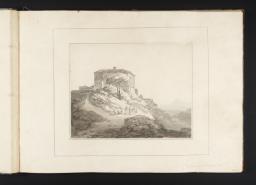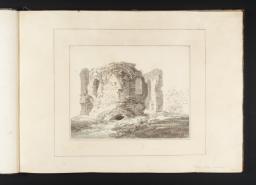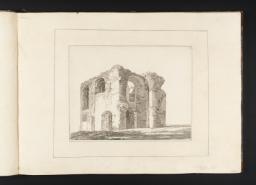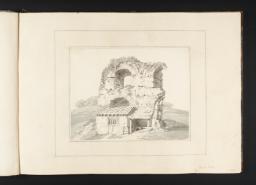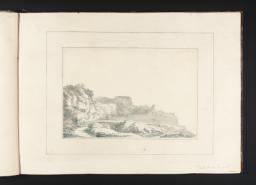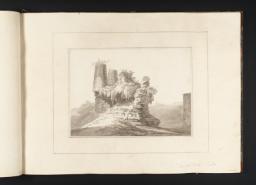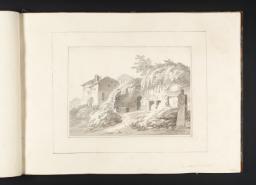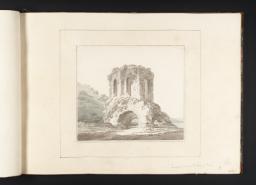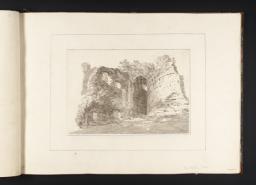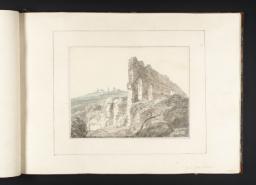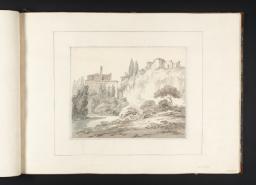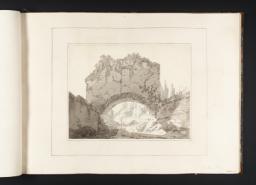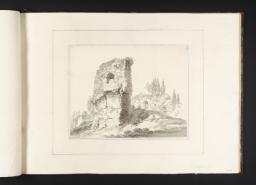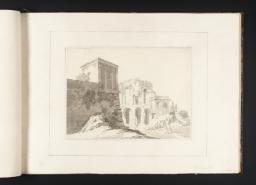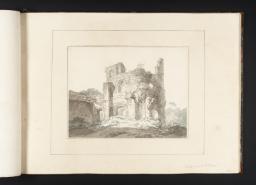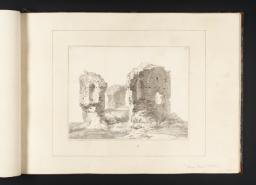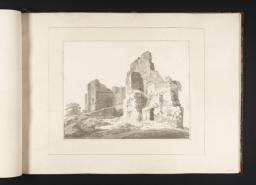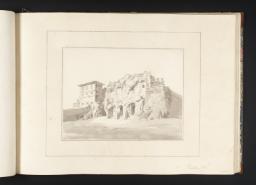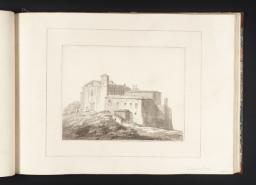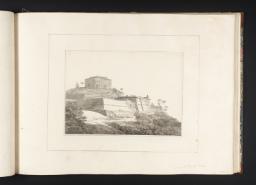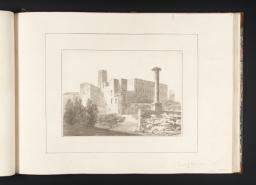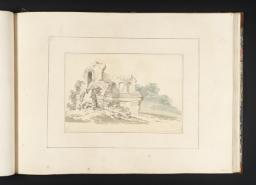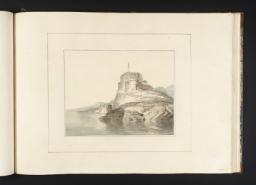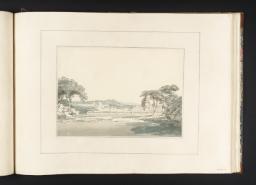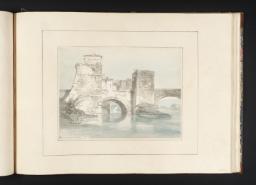Turner Bequest CCCLXXIII 1–64
Album half-bound in heavily rubbed marbled paper over boards with leather corners and gold-tooled leather spine with five raised bands
64 leaves of ‘stout cartridge paper on each of which a drawing has been mounted’ (Finberg), and 2 flyleaves of similar paper taken from the companion album (Tate; Turner Bequest CCCLXXIV), tipped in at front and back; album page watermark ‘A STACE | 1798’ (at least one album leaf wove); album page size 363 x 495 mm
Numbered 73 as part of the Turner Schedule; Ruskin endorsed the album ‘A.B. 172 P.M. Book of grey wash sketches of hardly any value’; the album was rebound in 1934; Finberg (1909) records an inscription in pen and ink inside the cover ‘Turner 4’; and in pencil ‘3–78’ and ‘Bought at Dr Monro’s Sale’.
Inscribed inside front cover by A.M. Hind in pencil ‘Rebound, & restored to its old form | 1934 A.M.H. | Flyleaves taken from old blanks at end of CCCLXXIV’ top left; stamped ‘CCCLXXIII’ top left; inscribed in pencil ‘CCCLXXIII’ towards top centre
Inscribed inside back cover by A.M. Hind in pencil ‘End paper’ at centre
64 leaves of ‘stout cartridge paper on each of which a drawing has been mounted’ (Finberg), and 2 flyleaves of similar paper taken from the companion album (Tate; Turner Bequest CCCLXXIV), tipped in at front and back; album page watermark ‘A STACE | 1798’ (at least one album leaf wove); album page size 363 x 495 mm
Numbered 73 as part of the Turner Schedule; Ruskin endorsed the album ‘A.B. 172 P.M. Book of grey wash sketches of hardly any value’; the album was rebound in 1934; Finberg (1909) records an inscription in pen and ink inside the cover ‘Turner 4’; and in pencil ‘3–78’ and ‘Bought at Dr Monro’s Sale’.
Inscribed inside front cover by A.M. Hind in pencil ‘Rebound, & restored to its old form | 1934 A.M.H. | Flyleaves taken from old blanks at end of CCCLXXIV’ top left; stamped ‘CCCLXXIII’ top left; inscribed in pencil ‘CCCLXXIII’ towards top centre
Inscribed inside back cover by A.M. Hind in pencil ‘End paper’ at centre
Accepted by the nation as part of the Turner Bequest 1856
Provenance:
Individual works commissioned by Dr Thomas Monro
Monro’s posthumous sale, Christie’s, London, 28 June 1833 (78, as ‘A Book containing 62 interesting sketches in the neighbourhood of Rome and Naples, by Turner, in Indian ink and blue’), £21
Bought by Thomas Griffith, presumably on behalf of Turner
Individual works commissioned by Dr Thomas Monro
Monro’s posthumous sale, Christie’s, London, 28 June 1833 (78, as ‘A Book containing 62 interesting sketches in the neighbourhood of Rome and Naples, by Turner, in Indian ink and blue’), £21
Bought by Thomas Griffith, presumably on behalf of Turner
References
This is one of two albums at Tate (the other being Turner Bequest CCCLXXIV) containing drawings made by Turner in collaboration with Thomas Girtin (1775–1802) at the behest of Dr Thomas Monro (1759–1833). Monro was physician to the King, and at some stage probably treated Turner’s mentally unstable mother. He was an amateur draughtsman and collector, who invited the young artists to no.8 Adelphi Terrace, the new home he had moved into in the winter of 1793–4, where, on winter Friday evenings, they made copies for him which he kept, giving Turner, and perhaps Girtin as well, three and sixpence (Turner later recalled that the sum was half a crown) and a supper of oysters.
Their subjects are apparently all copied from sketches by John Robert Cozens (1752–1797), the majority probably in sketchbooks that have been lost from the series belonging to William Beckford and now in the Whitworth Art Gallery, Manchester. Some are known through a series of tracings, known as the Beaumont tracings, referred to here by their numbers in the album now at the Yale Center for British Art, New Haven. Bell and Girtin suggest that the tracings are the source of the Monro School drawings, but it seems unlikely that the doctor would have supplied such approximate images as material for copying; see Tate D36468 (Turner Bequest CCCLXXIII 55). Finberg considered the drawings to be by Girtin, and referred to an account of Turner telling an auctioneer that ‘some drawings attributed to him were not by him.’ However, they are almost certainly all examples of the collaboration between Girtin and Turner noted by Joseph Farington in his diary for 12 November 1798: ‘Girtin drew in outlines and Turner washed in the effects.’1
It has been suggested that in the period when Turner and Girtin were working with him Monro owned few works by Cozens, and that the young artists’ copies were intended to act as substitutes to add to his own collection.2 Cozens himself was one of his patients towards the end of his life (he died in 1797), which would explain why the majority of the copies are taken from studies in sketchbooks, rather than from finished watercolours. There are however far too many such copies to be explained simply as substitutes for the doctor’s collection. Furthermore, several subjects are copied from watercolours by Edward Dayes (1763–1804). At the same time the traditional explanation, that Monro imagined the exercise would serve as useful practice for these already precocious and progressive watercolourists, does not ring true either.
Turner’s own motive in making so many copies according to the doctor’s repetitious and rather elementary prescription is not clear; Finberg questioned the value of such an exercise for two experienced young professionals such as both he and Girtin were. He concludes that Turner ‘soon found the work irksome, and ... after a time he refused to continue it.’3 This assertion is somewhat contradicted by the fact that ‘Monro’-type drawings appear in several stylistic guises, and clearly cannot all be dated to 1794–5, but must have been executed over the longer period indicated by Farington, namely during the winter of 1795–6; and a further group were probably made by Turner alone in 1797–8. His mother’s continuing dependence on Monro for professional help might explain this more prolonged interaction between the doctor and the artist.
Many of the drawings remained unmounted, but Monro had some placed in albums, of which this and Turner Bequest CCCLXXIV are examples. A large number of these drawings were dispersed at the sale of his effects after his death in 1833, and Turner made a point of acquiring several lots, so that the work he did for Monro is well represented in the Bequest. As the inscription ‘3–78’ recorded by Finberg confirms, this album was lot 78 in the third day’s sale at Christie’s, London, 28 June 1833. It was described as: ‘A Book containing 62 interesting sketches in the neighbourhood of Rome and Naples, by Turner, in Indian ink and blue’, and was bought by Turner’s agent Thomas Griffith, presumably on Turner’s behalf, for £21.
Finberg notes that J.L. Roget recorded Turner’s displeasure at the dispersal of these drawings when Monro’s collection was sold,4 but his purchase of several lots cannot be construed as an attempt to suppress his work for the doctor. It was more probably, as most scholars have agreed, an act of nostalgia.
Turner and Girtin also worked with Monro’s neighbour in Adelphi Terrace, John Henderson (1764–1833), at about the same time. Drawings recording this association are Tate D36616–D36624 (Turner Bequest CCCLXXVIII 1–9).
Most of the subjects in this album have been identified, perhaps by Girtin, on the laid-down versos of the drawings, and in considerably later pencil inscriptions, which transcribe these titles, in the lower right corner of the mount on the recto. Each drawing is bordered with two widely-spaced ruled pencil lines.
How to cite
Andrew Wilton, ‘Album of Copies of Italian views for Dr Thomas Monro c.1794–8’, sketchbook, April 2012, in David Blayney Brown (ed.), J.M.W. Turner: Sketchbooks, Drawings and Watercolours, Tate Research Publication, December 2012, https://www

